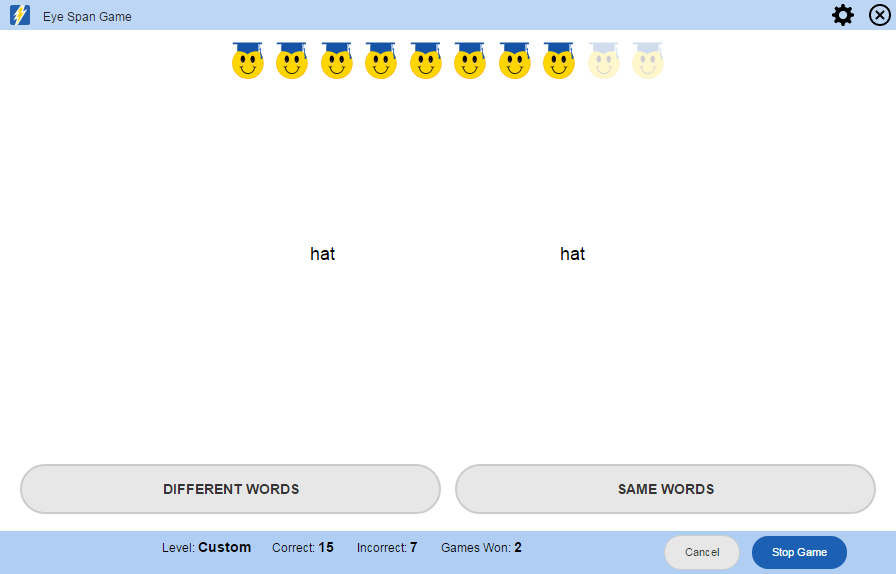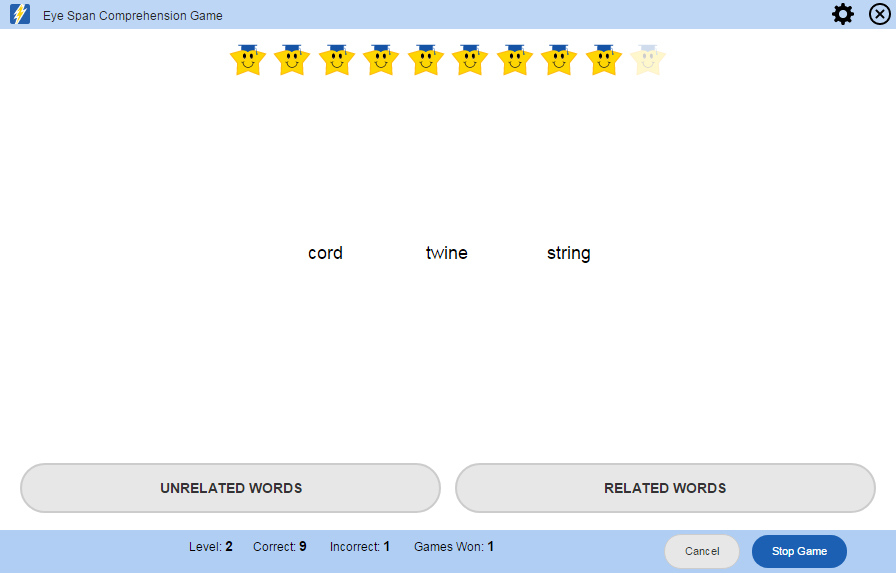Generally when we get individual students, or schools, onto the AceReader platform, we stress that improving your reading skills is not a competition. The only person you’re competing against is yourself, and the only scores that matter are those that show how much your speed, comprehension, and fluency improve as a result of your practice with the program.
That said, there are times when it may be useful to use AceReader in competitive ways, especially with the Games. Having friendly competitions can keep the students actively engaged in the work, and competitions give them a tangible goal towards which they can work.
The two most popular Games that teachers tell us they use for competitions are the Eye Span Game and the Eye Span-Comprehension Game. An eye span is the number of words your eye can see and your brain can process at a single glance. Many people read word-by-word; that means they only see and understand one word at a time. The eye and the brain, though, are capable of absorbing more information than that. When you take in more words at a time, you see them in context – that means you comprehend more of what you are reading. AceReader works to help users increase their eye spans and thereby their comprehension.
The Games work fairly simply. In the Eye Span Game, the user is shown two words to start and has only a short amount of time (determined by the BRS, the Base Reading Speed) in which to choose whether they are the same or different. As the Game levels increase in difficulty, the words are spaced farther apart, there may be more than two words, or the words may be displayed horizontally, vertically, or diagonally from each other. This forces the user to increase his eye span to take in more information. For each word combination he gets correct, he earns a smiley face. The object of the Game is to earn 10 smiley faces and advance to the next level.
Here is an example of the screen the user will see:

As you can see from the image above, the user’s display contains two words that are identical, so he would hit the “Same Words” button on the right. That earns him a smiley face, which is displayed at the top of the screen. The bottom runner keeps a tally of the level, how many screens the user has gotten correct or incorrect, and the number of games he has won.
Teachers turn this Game into a competition by having all students start the Game at the same time; the first one to earn the 10 smiley faces “wins.” Some teachers reward the winner with a small token, while other find the “kudos” is enough to keep the students motivated.
Reading quickly and recognizing the shapes of words are important skills, but they are of no importance if the reader does not understand the material. This is where the Eye Span-Comprehension Game comes in. This time, as the words flash on the screen, the user has to determine whether the words are the same or different in meaning. Take a look at the following screenshot:

“Cord,” “twine,” and “string” are clearly not the same words. However, they are all similar in meaning, so, in this case, the user would hit the “Related Words” button at the bottom. Again, each correct answer earns a smiley face, which is displayed at the top of the screen. When the user earns 10 smiley faces, he advances to the next difficulty level. As the levels become more difficult, the words may be spaced farther apart and appear horizontally, vertically, or diagonally. This forces the user to increase the eye span while ensuring that he maintains comprehension of what he reads. Teachers run competitions in the same way as they do for the Eye Span Game.
The other Games contained in the AceReader program can also be used for competitive purposes. After introducing the concepts of skimming and scanning, a teacher can have the students play the Skim/Scan Game. They assign a point each time a student finds the correct word in the text. The student plays the Game until they have earned ten points and then raise their hand. The first student to earn the ten points “wins.”
Students can also “self-compete” on the Games by treating them like video games. In this case, they are playing against themselves. Their goal is to achieve a certain level of difficulty in one session, and they can play until they reach that goal.
AceReader, although it is an educational program, can also be fun, and teachers and students should look for opportunities to enjoy the tasks they are performing. Be creative – look for ways that you can learn and have fun at the same time.
Do you have a novel way of playing the AceReader Games? Please leave us feedback in the comments section below so we can share it with other schools.
